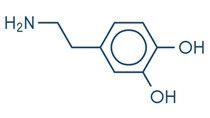Pleasure
- Tomás Morales y Durán

- Mar 20, 2023
- 3 min read

Copyright © 2023 Tomás Morales Duran. All rights reserved
Dopamine is an important neurotransmitter that acts in the mammalian central nervous system. A neurotransmitter is a substance that functions as a chemical messenger, carrying information from a neuron to a receiving cell.
Dopamine is part of the family of catecholamines, which, in turn, are basically formed by a catechol (3,4-dihydroxybenzene), which is linked by an ethyl bridge to an amino group.

Dopamine is synthesized in the cytoplasm of so-called dopaminergic neurons from the amino acid tyrosine, which is initially converted to L-dopa by the action of tyrosine hydroxylase. Subsequently, L-dopa is converted to dopamine through the action of aromatic L-amino acid decarboxylase. After being produced, dopamine is transported within the vesicles.
Dopamine release involves a process of exocytosis, that is, dopamine is released through vesicles that fuse with the cell's plasma membrane and release the neurotransmitter into the synaptic gap.
It is known that this neurotransmitter is involved in processes such as motor control, cognition, compensation, pleasure, humor and some endocrine functions, as well as being a precursor of other neurotransmitters: norepinephrine and epinephrine (adrenaline).
Dopamine is related to the so-called reward system of the brain, which is a neural circuit that directly influences emotions. This system guarantees motivation to carry out certain activities. When the neurons of the reward system are activated, they release dopamine in specific regions of the brain, causing an increase in the sensation of pleasure.
Some exogenous drugs directly affect the reward system, causing an increase in dopamine activity. With the time of use of a certain drug, changes are produced in the reward system in the long term, degrading it. Thus, drugs such as cocaine and alcohol are addictive because their use is associated with the sensation of pleasure.
The following exercise affects the production and release of this neurotransmitter.
During the performance of this exercise it is necessary to maintain the Duchenne smile established, essential to start the process.
The way in which the mind will be directed is given by the following formula:

Whose partial graphic interpretation is the following:

The abscissa axis represents time. The ordinate axis is the amount of air inside.
The zero value represents the rest state. The ups are inhalations and the downs are exhalations. The pressure is maximum at the minimum and zero at the maximum, just as a ball running through it would behave.
This perspective is from outside. It is not used seeing it like this. The mind is placed within the same plane of the curve and on it and stays connected throughout the shape by going up and down at different speeds, like a train car on a roller coaster.
This graph represents a finite section of a curve that has no end. The exercise is continuous and indefinite until a sufficient amount of dopamine has been released.
Don't forget to always smile.
"Smile. Sit up straight with your legs crossed. Place your hands palms up on your thighs.
Imagine that you are a leaf carried by the wind, imagine that each time you inhale the leaf rises and each time you exhale the leaf descends. As long as you stay focused, the blade will continue to fly at the rhythm of your breathing.
At times the inhalation is deep, at times shorter. At times the exhalation is deep, at times shorter.
If you perceive that your body begins to move to the rhythm of your breathing, leave it, do not repress it.
Do not pay attention to the sensations that arise, stay focused on the blade, on the movement.
Do not stop the exercise and keep smiling until it is your own laughter that takes you out of concentration and breaks your posture.





Comments